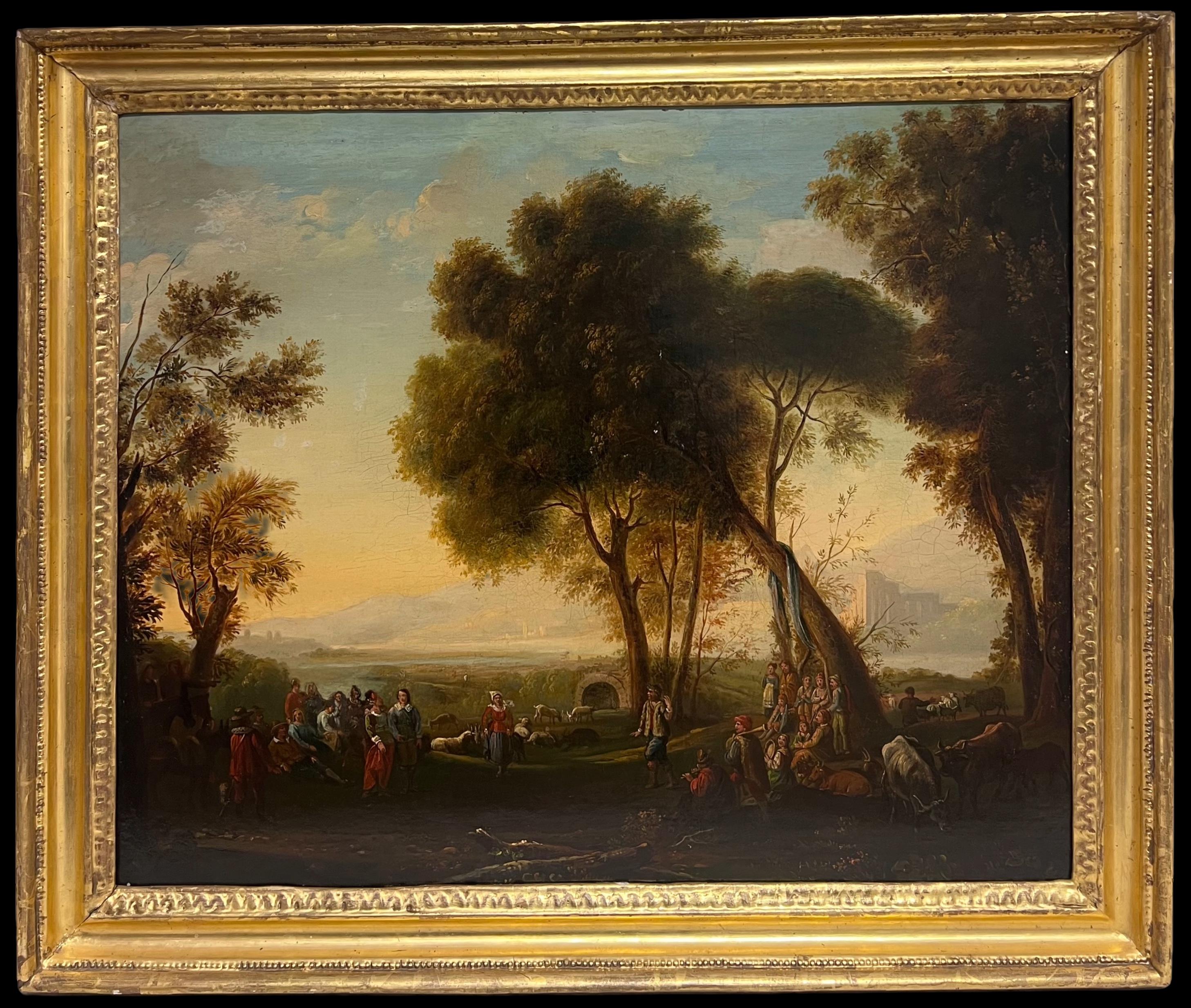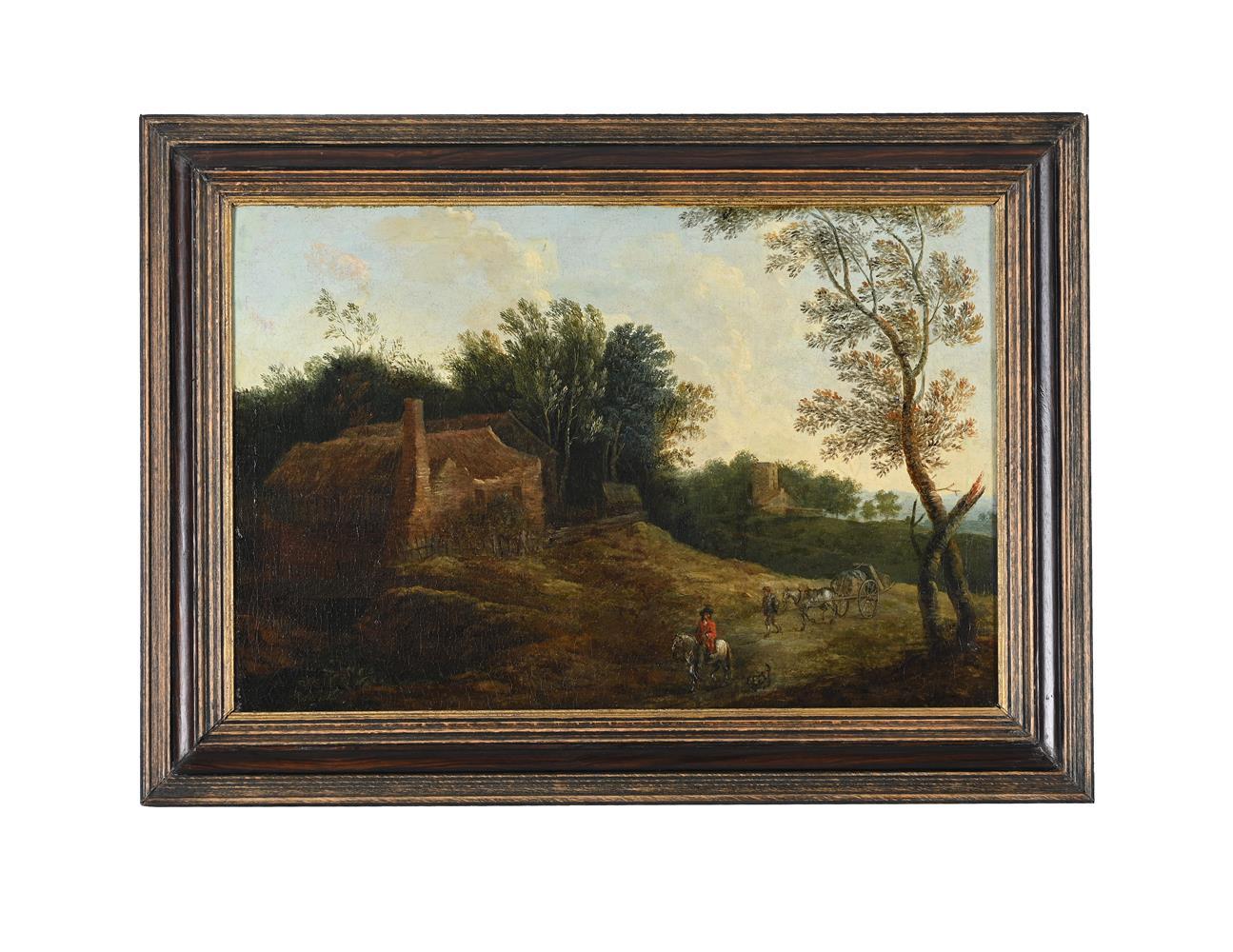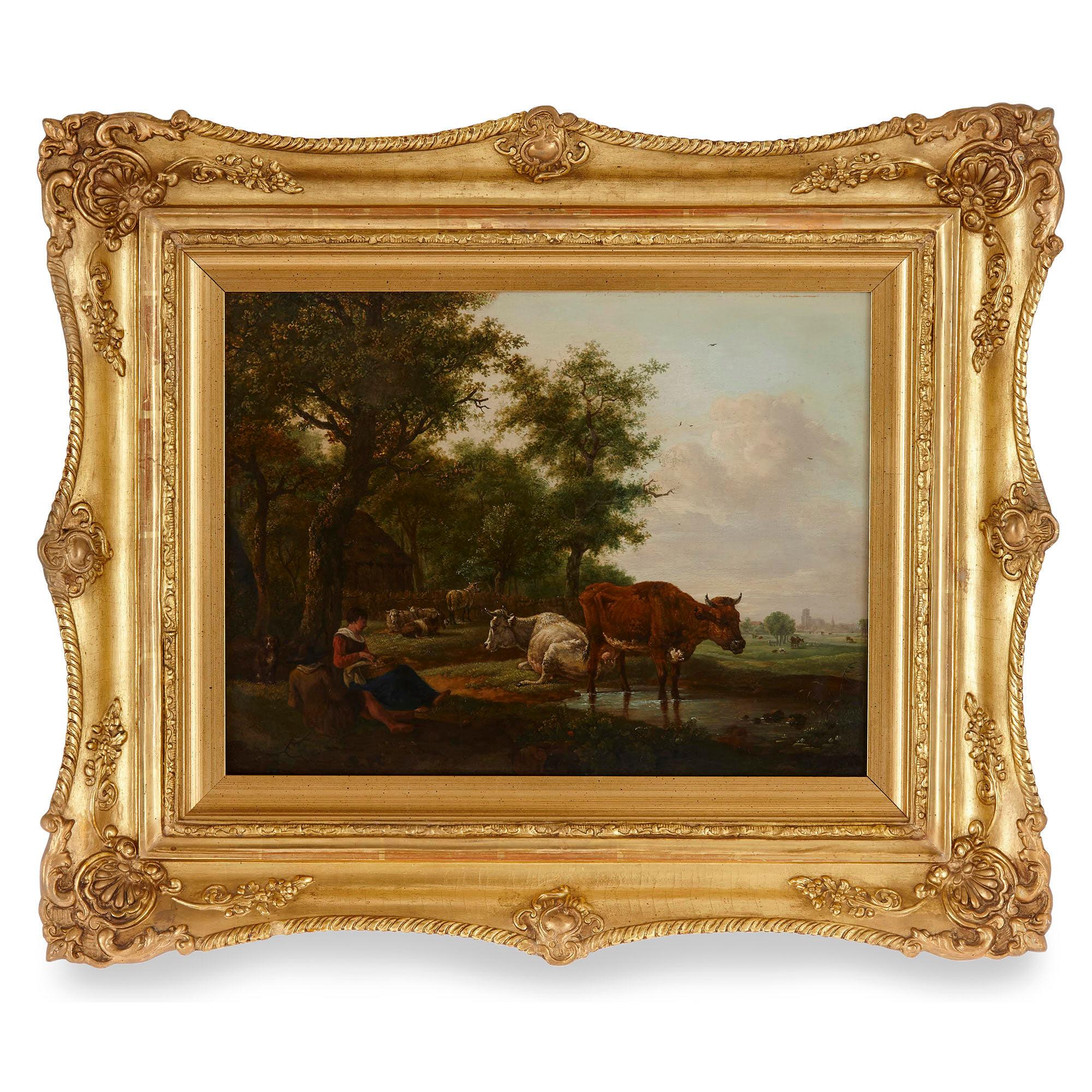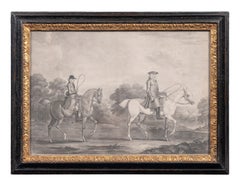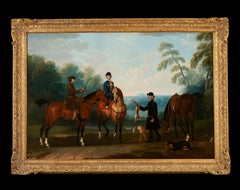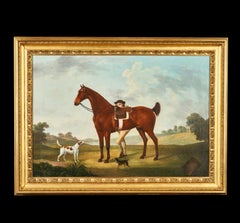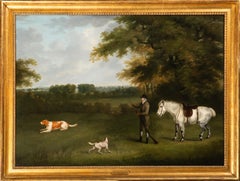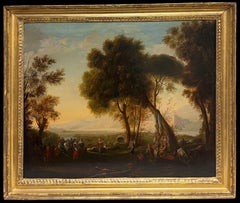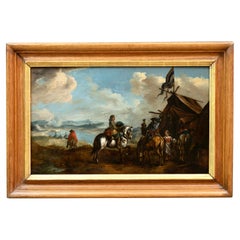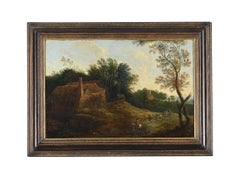Items Similar to Portrait of Cornelis and Michiel Pompe van Meerdervoort with Their Tutor
Want more images or videos?
Request additional images or videos from the seller
1 of 9
Portrait of Cornelis and Michiel Pompe van Meerdervoort with Their Tutor
$29,692.52
$49,487.5440% Off
£21,600
£36,00040% Off
€25,286.36
€42,143.9340% Off
CA$41,470.06
CA$69,116.7740% Off
A$44,975.26
A$74,958.7740% Off
CHF 23,622.72
CHF 39,371.2040% Off
MX$546,300.84
MX$910,501.4040% Off
NOK 295,600.94
NOK 492,668.2340% Off
SEK 278,324.79
SEK 463,874.6540% Off
DKK 188,860.62
DKK 314,767.7140% Off
About the Item
Attributed to Aelbert Cuyp (1620-1691)
An Equestrian Portrait of Cornelis (1639–1680) and Michiel Pompe van Meerdervoort (1638–1653) with Their Tutor and Coachman
Signed 'A. Cuyp. fecit' lower left
Oil on panel
28 3/4 x 35 7/8 in
Aelbert Cuyp was a prominent Dutch landscape painter during the Dutch Golden Age. Born in Dordrecht into a family of painters—his father Jacob Gerritsz Cuyp was also an artist—Aelbert became renowned for his luminous landscapes, pastoral scenes, and portraits that often captured the golden light of the late afternoon. His works are marked by a masterful use of light and atmosphere, drawing inspiration from Italianate landscapes while staying deeply rooted in Dutch realism.
Though less well-known during his lifetime compared to contemporaries like Rembrandt or Vermeer, Cuyp's reputation grew significantly in the 18th and 19th centuries, especially among English collectors, who admired the serene, sun-drenched quality of his work. His ability to blend portraiture, landscape, and animal painting into a cohesive and elegant composition remains a hallmark of his artistic legacy.
This painting, dated circa 1652, is a compelling study for Cuyp's masterpiece (now in the collection at The Met, New York) and example of his ability to merge landscape and portraiture with sophistication and flair. It portrays two young Dutch noblemen, Cornelis and Michiel Pompe van Meerdervoort, posed confidently on horseback, accompanied by their tutor and coachman. The boys belonged to a prominent patrician family from Dordrecht, and this portrait commemorates their social status and education.
Cuyp skillfully positions the figures within a sweeping, atmospheric landscape that serves as both a backdrop and a narrative element. The golden light, a Cuyp trademark, bathes the scene in warmth and elegance, while the horses and figures are rendered with precision and vitality. The composition reflects not only aristocratic ideals of youth, virtue, and discipline but also the importance of equestrian training and scholarly tutelage in noble households of the period.
- Attributed to:Aelbert Cuyp (1620 - 1691, Dutch)
- Dimensions:Height: 28.75 in (73.03 cm)Width: 36 in (91.44 cm)
- Medium:
- Movement & Style:
- Period:
- Condition:
- Gallery Location:Stoke, GB
- Reference Number:1stDibs: LU446316340592
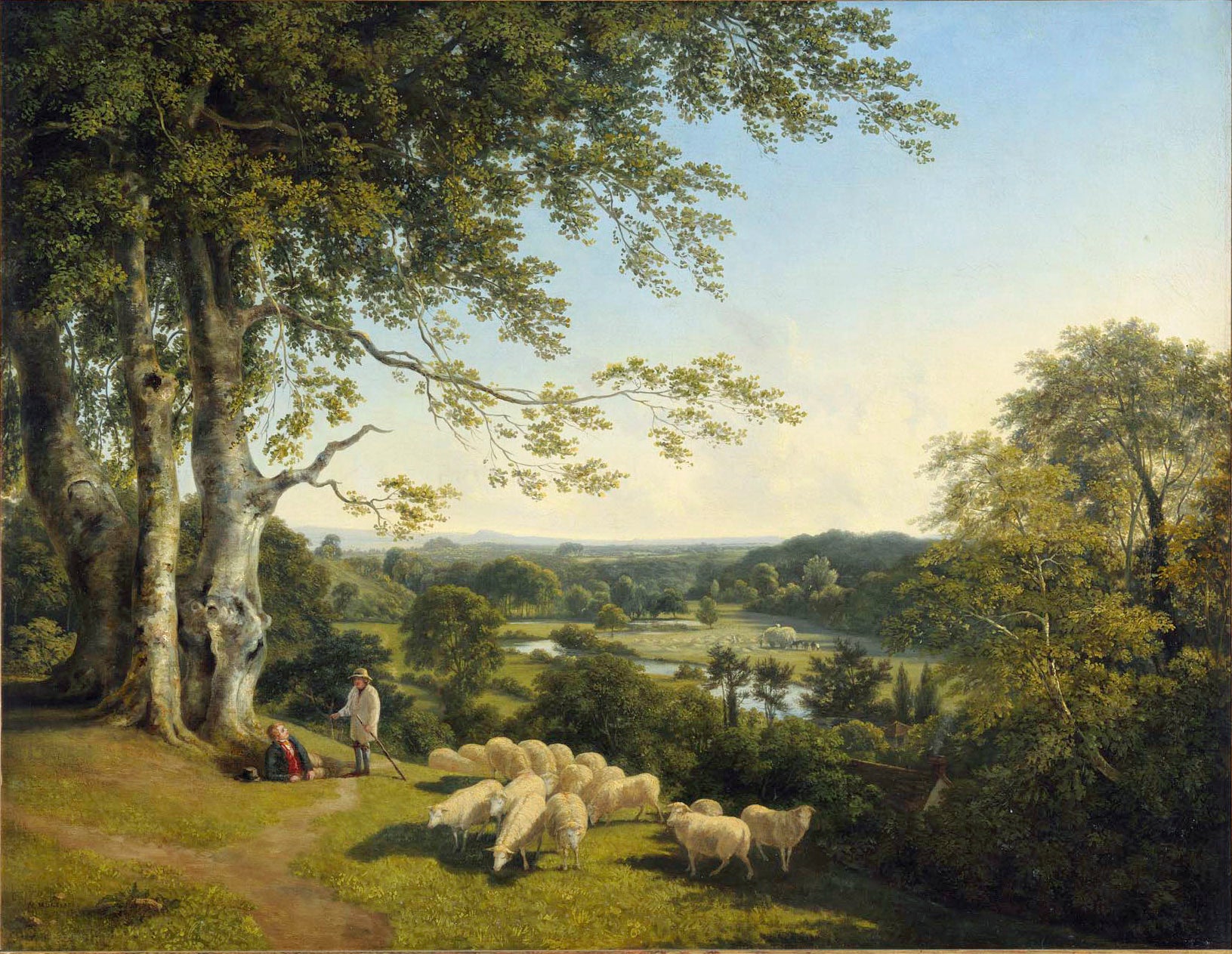
About the Seller
5.0
Recognized Seller
These prestigious sellers are industry leaders and represent the highest echelon for item quality and design.
Platinum Seller
Premium sellers with a 4.7+ rating and 24-hour response times
Established in 2009
1stDibs seller since 2016
189 sales on 1stDibs
Typical response time: 1 hour
Associations
LAPADA - The Association of Arts & Antiques DealersInternational Confederation of Art and Antique Dealers' AssociationsThe British Antique Dealers' Association
- ShippingRetrieving quote...Shipping from: Andover, United Kingdom
- Return Policy
Authenticity Guarantee
In the unlikely event there’s an issue with an item’s authenticity, contact us within 1 year for a full refund. DetailsMoney-Back Guarantee
If your item is not as described, is damaged in transit, or does not arrive, contact us within 7 days for a full refund. Details24-Hour Cancellation
You have a 24-hour grace period in which to reconsider your purchase, with no questions asked.Vetted Professional Sellers
Our world-class sellers must adhere to strict standards for service and quality, maintaining the integrity of our listings.Price-Match Guarantee
If you find that a seller listed the same item for a lower price elsewhere, we’ll match it.Trusted Global Delivery
Our best-in-class carrier network provides specialized shipping options worldwide, including custom delivery.More From This Seller
View All'Ironsides' a famous Hunter belonging to the Earl of Halifax
By James Seymour
Located in Stoke, Hampshire
James Seymour (1702-1752)
'Ironsides' a famous Hunter belonging to the Earl of Halifax
Mezzotint by R. Houston
Image size 9 1/4 x 13 1/4 in
Framed size 12 x 16 in
James Seymour was ...
Category
18th Century Old Masters Animal Paintings
Materials
Mezzotint
An elegant lady and gentleman hare coursing in an extensive landscape
By James Seymour
Located in Stoke, Hampshire
James Seymour (1702-1752) & Thomas Spencer (1700-1753)
An elegant lady and gentleman hare coursing in an extensive landscape
Oil on canvas
Canvas Size - 33 x 50 in
Framed Size - 41 x...
Category
18th Century Old Masters Figurative Paintings
Materials
Oil
$68,182 Sale Price
20% Off
A groom with a saddled bay hunter and dogs in an extensive landscape
Located in Stoke, Hampshire
Thomas Stringer (1722-1790)
A groom with a saddled bay hunter and dogs, in an extensive landscape
Dated 1754 lower left
Oil on canvas
Unframed size 25 x 36 in
Framed size 31 x 42 in
...
Category
18th Century Old Masters Landscape Paintings
Materials
Oil
$14,021 Sale Price
20% Off
A Huntsman with Dogs and Pony
Located in Stoke, Hampshire
John Nost Sartorius (London 1759-1828)
A Huntsman with Dogs and Pony
Signed 'JN Sartorius pin.' lower right
Oil on canvas
Canvas Size 26 3/4 x 37 in
Framed Size - 31 x 41 in
John No...
Category
18th Century Old Masters Animal Paintings
Materials
Oil
$21,444 Sale Price
20% Off
Smack rigged Royal yachts
Located in Stoke, Hampshire
Johann van der Hagen (1676-1745)
Smack rigged Royal yachts
Oil on canvas
Canvas Size 30 x 25 in
Frame Size 37 x 32 in
Provenance: The Parker Gallery.
Johann van der Hagen was a Dut...
Category
17th Century Old Masters Landscape Paintings
Materials
Oil
$5,443 Sale Price
20% Off
Herding cattle through a wooded river landscape
Located in Stoke, Hampshire
James Stark (1794-1859)
Herding cattle through a wooded river landscape
Oil on canvas
Canvas Size 18 x 24 in
Framed Size 23 x 29 in
James Stark (1794-1859): A Pioneer in Landscape P...
Category
18th Century Old Masters Landscape Paintings
Materials
Oil
$6,804 Sale Price
37% Off
You May Also Like
Fine 17th Century Dutch Golden Age Old Master Oil Figures in Classical Landscape
Located in Cirencester, Gloucestershire
Figures in Classical Landscape
Dutch School, 17th century
oil on canvas, framed
inscribed verso to label
framed: 23 x 27 inches
canvas : 20 x 24 inches
Provenance: private collection...
Category
17th Century Old Masters Landscape Paintings
Materials
Oil
Period Philips Wouwerman Style Credited Dutch Landscape
By Philips Wouwerman
Located in Roma, IT
Important oil on panel in the style of the great Dutch artist Philips Wouwerman (also Wouwermans) (1619 – 1668) a painter of hunting, landscape and battle scenes.
This beautiful pain...
Category
17th Century Baroque Landscape Paintings
Materials
Oil, Wood Panel
Dutch or Flemish Landscape with Figures & Animals
Located in Milford, NH
A beautifully detailed late 17th or early 18th century Dutch or Flemish landscape with cows grazing in the water, goats, dogs, and other animals near the water’s edge, under the watchful eye of the herdsmen, on a backdrop of rolling hills and trees. Oil on wood panel, unsigned, and housed in a Rudolph...
Category
Late 17th Century Flemish School Landscape Paintings
Materials
Oil, Wood Panel
Fine 17th Century Flemish Old Master Oil Painting Travellers Country Landscape
Located in Cirencester, Gloucestershire
Travellers in a Country Landscape
circle of Jacques d'Arthois (Flemish 1613-1686)
oil on canvas, framed
frame: 13.5 x 18.5 inches
canvas: 11 x 16 inches
provenance: private collectio...
Category
17th Century Old Masters Landscape Paintings
Materials
Oil
$2,694 Sale Price
20% Off
Antique Dutch painting of countryside with figures and animals
Located in London, GB
This beautiful oil on panel painting represents an ideal landscape: figures recline by a tree, cows and sheep laze in the late afternoon light, and the...
Category
18th Century Landscape Paintings
Materials
Oil, Panel
Flemish Early 17th Century Old Master Oil on Panel Painting Hunting Scene 1620
Located in Portland, OR
A highly important Flemish Old Master oil painting by Peter Van Lint (1609-1690), titled "Preparing for the Hunt", the painting is dated & signed by the artist, 1620. The painting wa...
Category
1620s Old Masters Landscape Paintings
Materials
Oil, Panel
More Ways To Browse
17th And 18th Century Portraits
17th Century Dutch Portrait Oil Paintings
17th Century Oil On Panel Portrait
Cornelis Hollander
Flair Holland
Jacob Cuyp
Christopher Willett Art
Connecticut Landscape Painting
English Beach Paintings
English Castle Art
Frank Chase
French Pointillist
Hoffman Oil
Iceland Painting
James Tower
Landscape With Ducks
Large Painting Oil Ship
Lily Pad Painting
